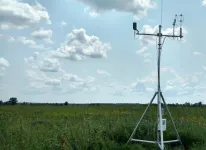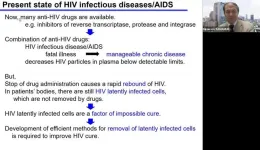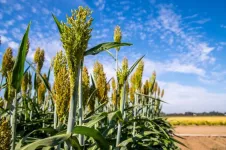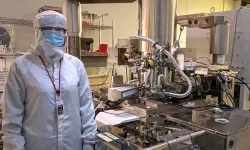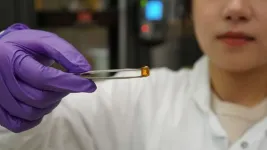(Press-News.org) Specially designed gardens could reduce the amount of a toxic chemical associated with tires entering our waterways by more than 90 per cent, new research shows.
Tired toxins
The chemical 6PPD-quinone can form when car tires interact with the atmosphere. It enters rivers and streams when rain runs off roads into waterways. It is toxic to coho salmon, rainbow trout and some other fish.
“Rain gardens”, or bioretention cells, are gardens engineered to reduce flooding and soak up contaminants when road runoff is directed onto them.
Rain gardens in Rain City
With the City of Vancouver, UBC researchers Drs. Timothy Rodgers (he/him) and Rachel Scholes (she/her) tested a Vancouver rain garden at 8th and Pine, pumping 14,000 litres of water spiked with 6PPD-quinone onto the garden for four hours and testing the water draining from beneath the garden at frequent intervals. They found only about two to five per cent of the chemical made it through, with about 75 per cent captured by the soil and plants.
Extrapolating their results using a computer model, the team predicted the garden would prevent more than 90 per cent of the chemical from directly entering salmon-bearing streams in an average year.
Save Our Salmon
Vancouver’s Rain City Strategy will build more “green infrastructure” including rain gardens, and municipalities could use the research to plan where and how to place these, the researchers say. This could include targeting areas with large highways that runoff into salmon-bearing streams and such systems could help meet multiple municipal environmental goals simultaneously. “Anywhere where you know there’s salmon, you should be trying to direct that runoff as much as possible into systems like this,” says Dr. Rodgers.
END
Rain gardens could save salmon from toxic tire chemicals
2023-06-21
ELSE PRESS RELEASES FROM THIS DATE:
New MU study examines variability of water, carbon in Missouri agriculture ecosystems and future impact on crops
2023-06-21
One of the main reasons plants use water is to allow them to absorb carbon dioxide from the atmosphere. This means that, in plants, the water and carbon cycles are tightly linked. In a new study, researchers from the University of Missouri and the United States Department of Agriculture (USDA) used this foundational principle to identify sustainable farming practices aimed at helping staple crops like corn and soybeans thrive during extreme weather conditions that have become more common in the Midwest.
This study examined how farming practices affect crop resilience to climate change by examining water and carbon ...
Welcoming two new journals to the PLOS portfolio: PLOS Mental Health and PLOS Complex Systems
2023-06-21
SAN FRANCISCO — PLOS today is announcing that it will soon launch two new journals: PLOS Mental Health and PLOS Complex Systems. PLOS sees these new journals as an opportunity to give evolving research communities opportunities to forge a new path for research in the field. Whether that means welcoming new ways of sharing research transparently or cementing new policies that enable research to be evaluated and rewarded more fairly, or simply finding a broader audience where research can make a greater real-world impact.
PLOS Mental Health provides a dedicated venue for all mental health research, connecting global experts from a broad range of disciplines and addressing challenges ...
A new, promising weapon in the fight against HIV
2023-06-21
A research team led by Tokyo Medical and Dental University (TMDU) has identified a molecular compound that activates latent HIV-1 in cells, showing promise for HIV treatments
Tokyo, Japan – A multi-institutional research group led by researchers from Tokyo Medical and Dental University (TMDU) has made a significant and promising step forward in our ability to treat human immunodeficiency virus type 1 (HIV-1), the virus underlying acquired immunodeficiency syndrome (AIDS).
To appreciate their accomplishment, we must first know a little about why HIV-1 is difficult to eliminate. ...
A roadmap for gene regulation in plants
2023-06-21
– By Will Ferguson
For the first time, researchers at the Department of Energy’s Lawrence Berkeley National Laboratory (Berkeley Lab) have developed a genome-scale way to map the regulatory role of transcription factors, proteins that play a key role in gene expression and determining a plant’s physiological traits. Their work reveals unprecedented insights into gene regulatory networks and identifies a new library of DNA parts that can be used to optimize genetic engineering efforts in plants.
“Transcription factors regulate things like how plants grow, how much fruit they produce, ...
Cave excavation pushes back the clock on early human migration to Laos
2023-06-21
CHAMPAIGN, Ill. — Fifteen years of archaeological work in the Tam Pa Ling cave in northeastern Laos has yielded a reliable chronology of early human occupation of the site, scientists report in the journal Nature Communications. The team’s excavations through the layers of sediments and bones that gradually washed into the cave and were left untouched for tens of thousands of years reveals that humans lived in the area for at least 70,000 years – and likely even longer.
“When we first started excavating the cave, we never expected to find humans in that region,” said University of Illinois Urbana-Champaign anthropology professor Laura Shackelford, who led ...
New microcomb device advances photonic technology
2023-06-21
A new tool for generating microwave signals could help propel advances in wireless communication, imaging, atomic clocks, and more.
Frequency combs are photonic devices that produce many equally spaced laser lines, each locked to a specific frequency to produce a comb-like structure. They can be used to generate high-frequency, stable microwave signals and scientists have been attempting to miniaturize the approach so they can be used on microchips.
Scientists have been limited in their abilities to tune these microcombs at a rate to make them effective. But a team of researchers ...
Now, every biologist can use machine learning
2023-06-21
By Lindsay Brownell
(BOSTON) — The amount of data generated by scientists today is massive, thanks to the falling costs of sequencing technology and the increasing amount of available computing power. But parsing through all that data to uncover useful information is like searching for a molecular needle in a haystack. Machine learning (ML) and other artificial intelligence (AI) tools can dramatically speed up the process of data analysis, but most ML tools are difficult for non-ML experts to access and use. Recently, automated machine learning (AutoML) methods have been developed that can automate the design and deployment ...
University of Toronto Engineering researchers are using electric fields to control the movement of defects in crystals
2023-06-21
An international team of researchers, led by University of Toronto Engineering Professor Yu Zou, is using electric fields to control the motion of material defects. This work has important implications for improving the properties and manufacturing processes of typically brittle ionic and covalent crystals, including semiconductors — a crystalline material that is a central component of electronic chips used for computers and other modern devices.
In a new study published in Nature Materials, researchers from ...
Assessment of a peer support group intervention for undocumented Latinx immigrants with kidney failure
2023-06-21
About The Study: This study of 23 undocumented immigrants with kidney failure receiving emergency dialysis found that a peer support group intervention achieved feasibility and acceptability. The findings suggest that a peer support group may be a patient-centered strategy to build camaraderie and provide emotional support in kidney failure, especially for socially marginalized uninsured populations who report limited English proficiency.
Authors: Lilia Cervantes, M.D., of the University of Colorado, Anschutz Medical Campus, in Aurora, is the corresponding author.
To ...
Biodegradable gel shows promise for cartilage regeneration
2023-06-21
A gel that combines both stiffness and toughness is a step forward in the bid to create biodegradable implants for joint injuries, according to new UBC research.
Mimicking articular cartilage, found in our knee and hip joints, is challenging. This cartilage is key to smooth joint movement, and damage to it can cause pain, reduce function, and lead to arthritis. One potential solution is to implant artificial scaffolds made of proteins that help the cartilage regenerate itself as the scaffold biodegrades. How well the cartilage regenerates is linked to how well a scaffold can mimic the biological properties of cartilage, and to date, researchers have struggled ...
